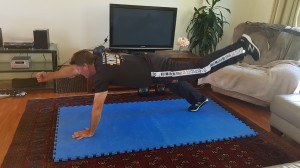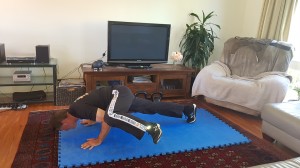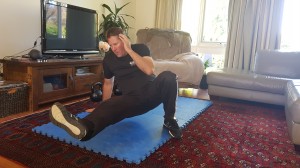Krav Maga Training In Isolation, what are the options?

First off, let us consider the word Isolation and how that changes the training dynamic.
Obviously we can no longer attend our regular class situation whether due to travel or the current self imposed Covid 19 Isolation but, in this day and age we have so many other options at our finger tips.
The internet can provide numerous training options from online classes to training videos of all kinds, but we still need to be able to re-invent our own training regime in our own space.
It’s not as hard as it sounds, although it will require a little creativity and then some self control / determination and focus to enact our training plan.
The beauty of Krav Maga in Isolation is you can work it into your daily routine with ease. You can train all through your dwelling, be it a house, unit or hotel room. They all have doorways, door frames, walls and furniture that can be used as training tools with a little creativity.
So let us look at the basic options and then we’ll go into some detail on each.
- Visualization:- Neuro Linguistic Programming.
- Dry Driiling:- Execution of technical material without a partner.
- House fighting:- The use of the dwelling, halls’ walls and doorways.
- Furniture:- Training from different seated positions / in and around furniture as obstacles / use of furniture as common objects.
- Punching bag:- If you have one.
- Mirror training:- If you have one.
- Mental conditioning:- Meditation, breathing, power posing.
- Fitness and conditioning:- Body weight exercises and stretching.
Okay, so let’s look at each aspect in detail. Keeping in mind that these options are all able to be used in combination with each other depending on how creative you want to be.
Visualization:- This can be done sitting at the dinner table, sitting on the couch, at your work station, flat on your back in bed or even on the toilet!
There’s 2 Options here,
1. Visualize a technique that you want to work on and do it as you would in a dry drill by ramping each step of the technique until you have the whole thing, then later dry drill it exactly as you visualized it.
Or
2. Start by visualizing an attack happening to you in what ever position you’re in eg:- seated or lying down.
But don’t limit yourself by your environment as you can visualize a mugging situation in the street, car jacking, anything that comes to mind really.
When you start your visualization you can visualize as though there is nobody there and you are only going through the technical aspects of the defence for a specific attack, then you should add in the reality by picturing the attacker as well. When you do that, work from complete failure to complete success step by step and repeat each visualization 4 or 5 times before moving on to the next step.
Make sure you visualize the same attack each time and with each attack the same response and end result for that stage of the visualization process.
Eg:-
1. I’m attacked, I’m completely surprised and am able to make no defences and get bashed very badly, maybe even to death. The attacker leaves me for dead.
2. I see the attacker just before I’m struck and start to cover up, I don’t have time to defend properly and still get bashed but manage to survive. The attacker makes a hasty escape.
3. I see the attacker, recognize what’s about to happen and manage to defend and get away with only mild injuries. Attacker heads the other way having failed.
4. I see the attacker, recognize what’s about to happen and make a very good defence leaving the attacker disabled and am able to disengage, I move to a safe zone and check myself for bleeding and other injuries then call the police to report the incident.
Keep it as simple a scenario as possible but always start with the worst possible out come and work to complete success.
Dry Drilling:-
Take whichever technique that you want to work on and mentally break it down into at most 3 stages then work stage 1 several times, add stage 2 and then stage 3.
As you work through the drill you repeat stage 1 say 3 times, then add stage 2 and repeat 1 & 2 together 3 times then add stage 3 and you have the whole technique which you then repeat 3 times or as many times as you wish, repetition is good!
Eg:- 360 / outside defence,
Step 1. Just make the defence.
Step 2. make the defence with simultaneous counter.
Step 3. make the defence and counter and add tactical movement and scanning for other attackers, exits, common objects etc.
House fighting:-
One of my favourites!

This requires a bit of imagination, and would be good if you were the only one present at the time (due to others thinking you may have lost the plot).
You can do this anywhere in the house and if you have a long hall with lots of doorways it’s even better.
You will need to be warmed up and you need to keep safety in training in mind at all times! Door frames are very unforgiving opponents!
Starting in any location in the house from standing, simply shadow fight your way around the house using the furniture and walls as the ring so to speak.
Visualize opponents popping up in doorways, in the kitchen, the hall, anywhere really.
You’re moving through the whole environment and you can use all the angles to your advantage.
Halls are especially good for this as you move along the hall you can visualize attackers in the doorways, in font of you, to the sides and behind you, multiple attackers from multiple sides!
Work the angles!

You will find here that you need to be very spatially aware and have good control of your limbs, not much in the way of circular motion strikes, no roundhouse kicks, hook punches can be used but carefully. They are good for punching around a corner or to a door frame (with gloves or open handed), but due to the confined nature of a hall you’ll mainly be making front, side and back kicks with straight punches, elbows and forward, downward and upward hammer strikes.
If you have good gloves and solid door frames you can even strike the door frames from all kinds of angles with some care!
Try to add in all kinds of releases from chokes and head locks and really consider the use of the environment, practice ramming the attackers head into door frames etc, use common objects and the furniture (with care!) as both obstacles for your attacker and weapons for yourself.
This is a lot of fun and will improve your skills and control and you should try to use peripheral vision also as part of the exercise.
Start slowly and once you get the idea go as fast as you’re comfortable with.
But most of all don’t hurt yourself or the house!
Your home and contents insurance won’t cover any damage to you or the house! Nor will Krav Maga Canberra!
Furniture fighting:-
Training from different seated positions / in and around furniture as obstacles / use of furniture as common objects.

Exactly as in House fighting only now you start in a seated position, can be on the lounge (which provides some difficult scenarios) or in a regular chair or seated with your legs under the dining table etc.


Visualize a scenario then work on making defences whilst seated, then getting up to deal with the problem while being attacked, then getting up and intercepting the attacker, then retreating behind the seat or lounge, then if possible use the seat as a defensive tool / shield. Work the time line! (be carefull!)
Punching bag, if you have one:-
You can do the usual of working striking combinations or just single techniques or you can be far more creative and start from varying angles and make both defences and attacks on the bag.
Eg:- make inside sweeping defence to the air then coming back with the same hand to make a hammer strike to the bag, this will give you a much better feel for the defence and allow you to build more striking power at the same time.
If you have room you can make forward or backward rolls to the bag then come up fighting, this will improve your proprioception enormously and you’ll get a much better feeling for range.
You can do the same with break falls forward, backwards and sideways which also gets you attacking from the ground with your feet, then works your get ups to continue attacking the bag from standing.
Think out of the box, the options are endless here!
Mirror training:-
There’s not a lot to say here, it’s a great tool if you have one in an area where you can move.
Basically you can dry drill or shadow fight in the mirror using the mirror to see how good (or poor) you look.
You can even do 360 or punching combo’s in the bathroom mirror!
Mental conditioning:- Meditation, breathing and power posing.
Meditation:-
While meditation really isn’t my thing, on the odd occasion that I have used it to clear my head of noise, I’m not talking audible noise but the kind of white noise that goes on in our heads, too much obscure brain activity with no focus type of noise, it has been very helpful.
So in the isolation environment it’s not a bad tool to use prior to, and after training, to clear your head and give focus.
I like to stare at a spot on the wall until all else is blank and I only see that spot, it’s very settling for the mind and afterwards allows you to perform somewhat better with much more focus and clarity.
It would be worth doing a little research on various types of meditation if you were interested in delving deeper as different methods work better for different people, the above is just one example of what works for me.
Abdominal Breathing:-
A really good tool for settling the nerves and used by many Special Forces personnel around the world prior to and during opps.
It’s also a technique Psychologists use when helping people with anxiety etc.
Again it’s very settling for the mind, lowers the pulse rate and generally brings calm to the nervous system.
Essentially you should breath in and out to a count (6 to 8 works for me) the more practice you do the longer your count will become.
In:-
It should be that your diaphragm / stomach region rises first and finishes with your upper chest inflating last.
Out:-
Then the chest empties first with the diaphragm /stomach region emptying last, with counting the same number on the way in and out, slowly but surely.
Power Posing:-
Why use this in isolation?
Well it’s a good way to make you feel better about yourself (I Am A Winner!). It’s about adopting the correct mentality to both survive the isolation and all the mental aspects associated with it, and having a winning mentality while training is especially useful when house fighting or bag working.
There are three basic poses:-
1. The winner with the fists clenched and held high above the head just as you would see an athlete on the podium.
2. The arms crossed and the chest fully inflated, head held high.
3. Hands on hips with the chest fully inflated and head held high.
Believe it or not doing these stances will lift your mental state.
You should do your stance in a mirror for a period of at least 30 seconds or more and embrace it, you are a winner!
If you put your aggressive face on while doing the arms crossed or hands on hips position this can also raise your aggression level somewhat and is worth doing as an exercise prior to the fighting training or bag work.
Fitness and Conditioning:-
Should be an integral part of your Krav training regime even if only for body maintenance.
If you have a gym then by all means use it, but try to think of more functional forms of exercise when it comes to Krav training.
Body weight exercises and kettlebells if you have some are best for us.
Again you’ll need to be creative here to keep it interesting if your isolation is going to be prolonged.
There are many variations of body weight exercises, take the push up / plank family, how many different ways can you do these?
The main thing to keep in mind is that the exercises that you’re doing has some purpose other than just going through the motions to keep fit. You want to be targeting whole muscle groups! Not just focusing on aesthetics, biceps curls for instance, how is this going to help your Krav?
If you ask yourself that exact question when choosing a workout, it should be easy to find something that will fulfill both your need to break the workout boredom / exercise burnout cycle, and create something that is interesting, fun and functional in relation to Krav Maga.
Stretching should also be an integral part of your workout, prior and post workout.
It doesn’t hurt to spend some time a couple of times a week on stretching alone, think about your mobility and what that’s going to look like when you’re older!
The same applies here with the internet being a great source of info.
Just be careful that you’re not doing harm to yourself, stretching shouldn’t be excruciatingly painful in nature. slowly but surely wins the race here!
Conclusion:-
Training in Isolation is not hard, you just need to be creative and think outside of the box.
Try different approaches, have a plan and be prepared to adjust that plan if it doesn’t work for you.
Don’t be scared to try different approaches as there is nobody there to judge you other than yourself, if it’s not working, move on, try something else.
Just go for it!
Blog post by Dave Sargent, Senior Instructor and school owner at Krav Maga Canberra
Click here to:-
Join us at Krav Maga Canberra



